The Kia Picanto and Toyota Aygo are both among the smallest cars you can buy – perfect for tackling urban traffic and slipping into teeny parking spaces.
If you're looking for a companion to cross the concrete jungle, which of these dinky city cars deserves your cash? We'll compare them inside and out to help you pick your favourite.
Read our Kia Picanto review or our Toyota Aygo review for a more in-depth look at both cars.
Kia Picanto vs Toyota Aygo compared
| Kia Picanto | Toyota Aygo |
Pros:
| Pros:
|
Cons:
| Cons:
|
Styling and design
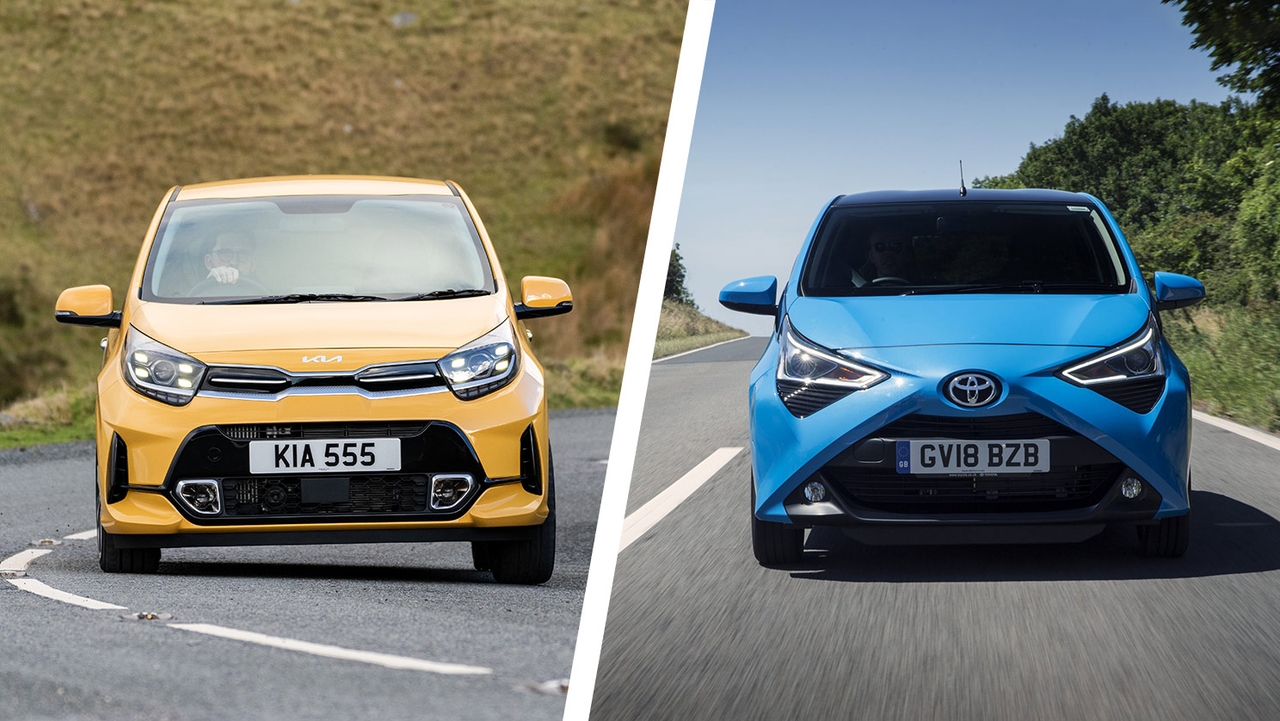
These might be small, affordable cars, but both come out of the blocks with sharp, eye-catching styling. The Picanto has big, bold headlights either side of its thin 'tiger nose' grille, giving its front end an instantly recognisable look. Looking down the rest of the bodywork, function has clearly been prioritised over form – there's not much in the way of styling, just a short-yet-tall profile that hints at the surprisingly practical space hidden within. Used shoppers should keep an eye out for tough-looking X-Line and sportier GT-Line cars.
The Aygo is even bolder, however. It has an oversized 'X' motif that runs down the bonnet line and above the angular headlights, meeting at the Toyota badge in the middle, before being carried on down the bumper. It also makes clever use of blackout panels behind the front headlights and pillars to give the impression of a 'floating' roofline similar to a Mini Hatchback or Suzuki Swift. Step around the back and you'll also spot the Aygo's bootlid is a simple large pane of glass, compared with the Picanto's more conventional bootlid, which incorporates some of the rear bodywork.
Interior and practicality
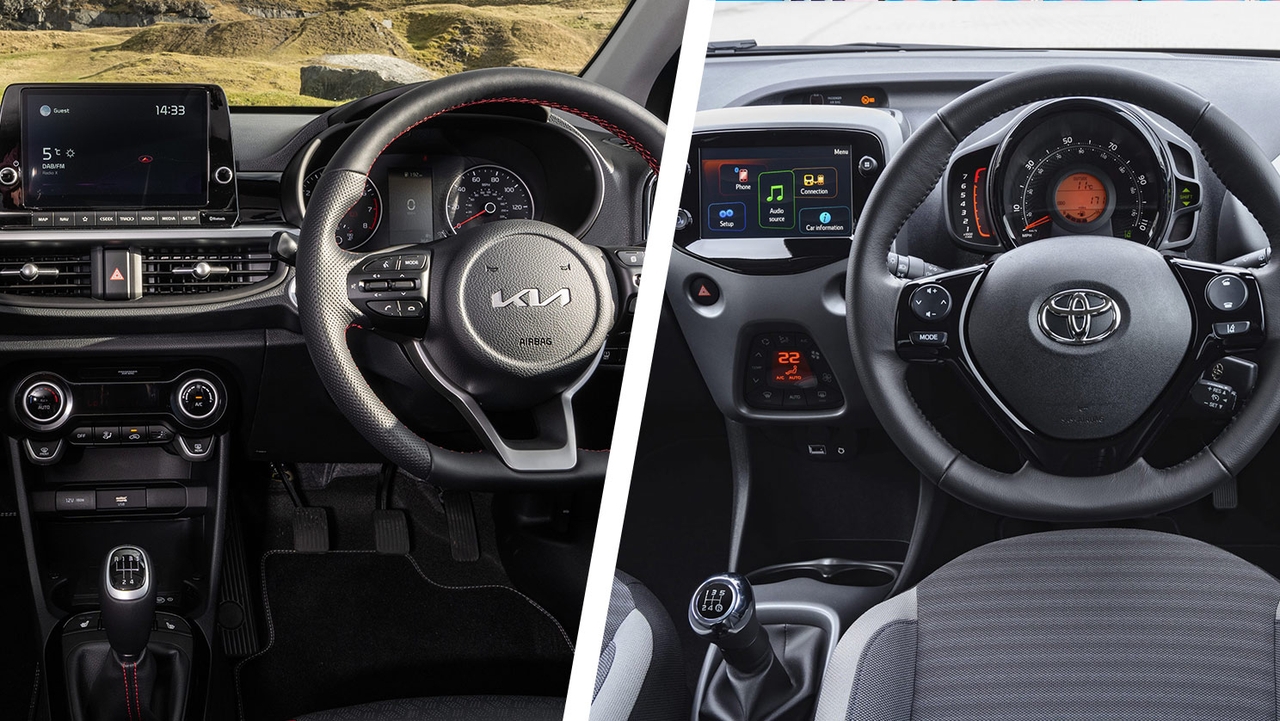
Both of these cars sit at the affordable end of the spectrum, so don't go expecting to travel in the lap of luxury in either. Nevertheless, the Picanto appears to have focused a little more on substance, while the Aygo's cabin is perhaps a touch more stylish. There's a lot of black plastic in the Picanto with little more than a strip of silver plastic and some oval air vents to lift the ambiance. The Aygo, on the other hand, features a central dashboard pod that resembles a cyborg, flanked by a pair of funky eyeball air vents – although the construction doesn't feel quite as solid as the Kia if you subject it to a stiff prod.
Entry-level cars in either lineup don't actually include an infotainment system. You only have to take one step up in the Aygo range to X-Play trim to get a screen, and then one more jump to X-Trend for it to include Apple CarPlay and Android Auto. Adding the same equipment to a Picanto means you need to journey higher up its trim range, with a bigger price tag as a result. Neither car's touchscreen is perfect – the Picanto's graphics are fussy and hard to read at a glance, while the Aygo's screen is simpler but looks cheaper and is sluggish to respond.
In any other context, the Picanto's sub-3.6-metre length would make it the most compact choice, but the Aygo is less than 3.5 metres long, undercutting tiny rivals like the Fiat 500 and Hyundai i10. Whatever fractional gain the Aygo wins for parking ease, however, isn't worth the loss in practicality. There's actual room for adults in the Picanto's back seats, while the Aygo's rear bench is best saved for occasional quick lifts or extra storage. What's more, the Kia's boot is noticeably larger and easier to access thanks to the wider boot lid.
Engines and performance

It's a rare occasion when a Kia Picanto comes out of a comparison looking like the high-performance choice, and yet here we are. The Korean car's entry-level 1.0-litre petrol engine is fine around town but quickly starts to feel underpowered at higher speeds. Upgrading to the 1.25-litre petrol, sadly, brings only a very modest jump in performance. At the top of the range, however, you'll find Kia's 1.0-litre turbo petrol. It's a little pricey but, in such a small car, its 99hp output feels quite meaty, with enough grunt to keep up with motorway traffic.
Conversely, the Aygo gets one engine only – a 1.0-litre petrol without a turbo to its name. Just like the basic 1.0-litre Picanto engine, this unit is fine for urban driving but needs to be worked very hard to get up to motorway speeds. It also sounds quite thrashy as you're building pace, with engine noise very prominent under hard acceleration and never really fading away once you hit cruising speed. The Picanto's engines are quite a lot quieter in use.
One final note under the bonnet – both cars can be optioned with automatic gearboxes, but both are the automated-manual variety. These are known to be a bit jerky and dull-witted on the road, so we'd strongly recommend choosing manual versions of either car if you're able to. Buyers after small automatic cars will be much better off with smooth hybrids like a Toyota Yaris or Honda Jazz.
Driving
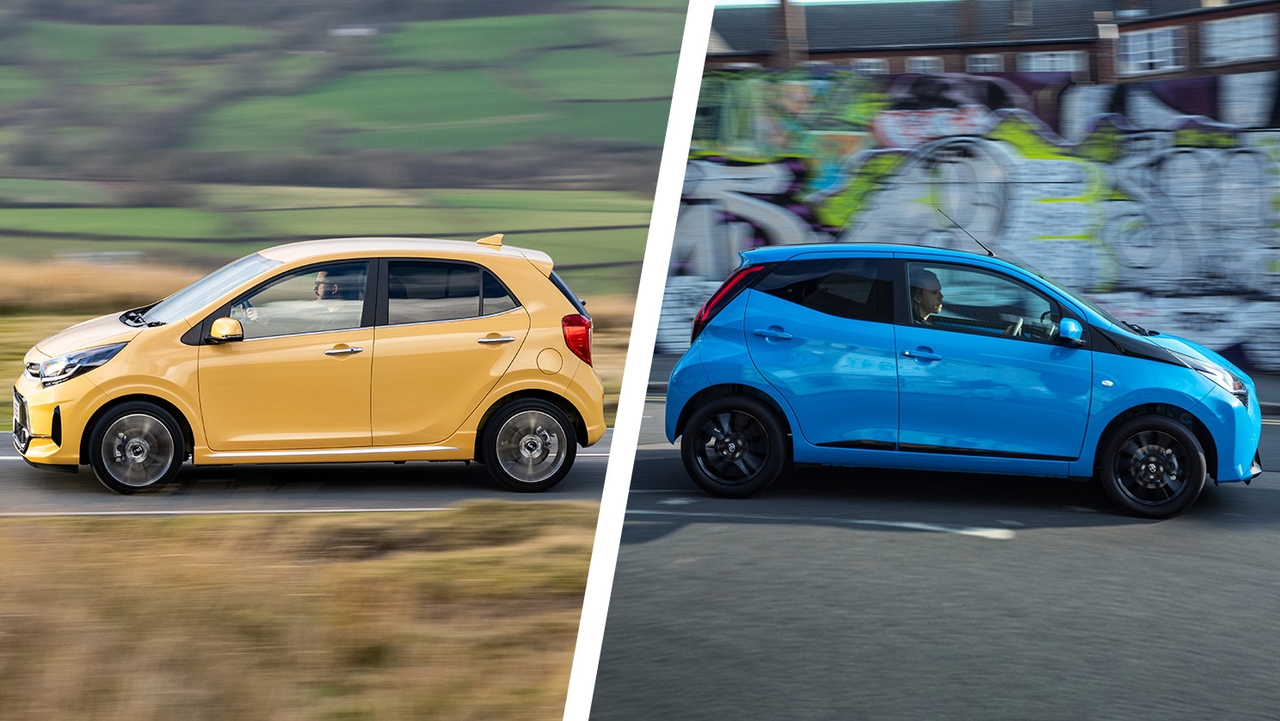
Neither car is likely to impress you with their engine power but the Kia at least tries to make each drive entertaining. Its suspension is slightly firm, which means you occasionally bounce over big bumps, but also gives the car superb body control. Combined with the Picanto's short wheelbase and quick steering, you get a car that relishes rapid direction changes without losing the ability to remain composed at higher speeds. It also does a reasonably good job at insulating the cabin from tyre and suspension noise.
Initial impressions of the Toyota are good. At slower urban speeds, there's a fraction more compliance in the suspension but the tradeoff is a car that feels less settled as the speeds increase. It lacks the agility of the Picanto, too, and rolls more obviously in tight turns. The light steering takes little effort to turn but doesn't do a great job of communicating how much grip is available on the front axle, with inconsistent weighting as you add more steering lock. It's also a little noisier than the Picanto, with more engine, tyre and wind roar making it inside.
Value and reliability
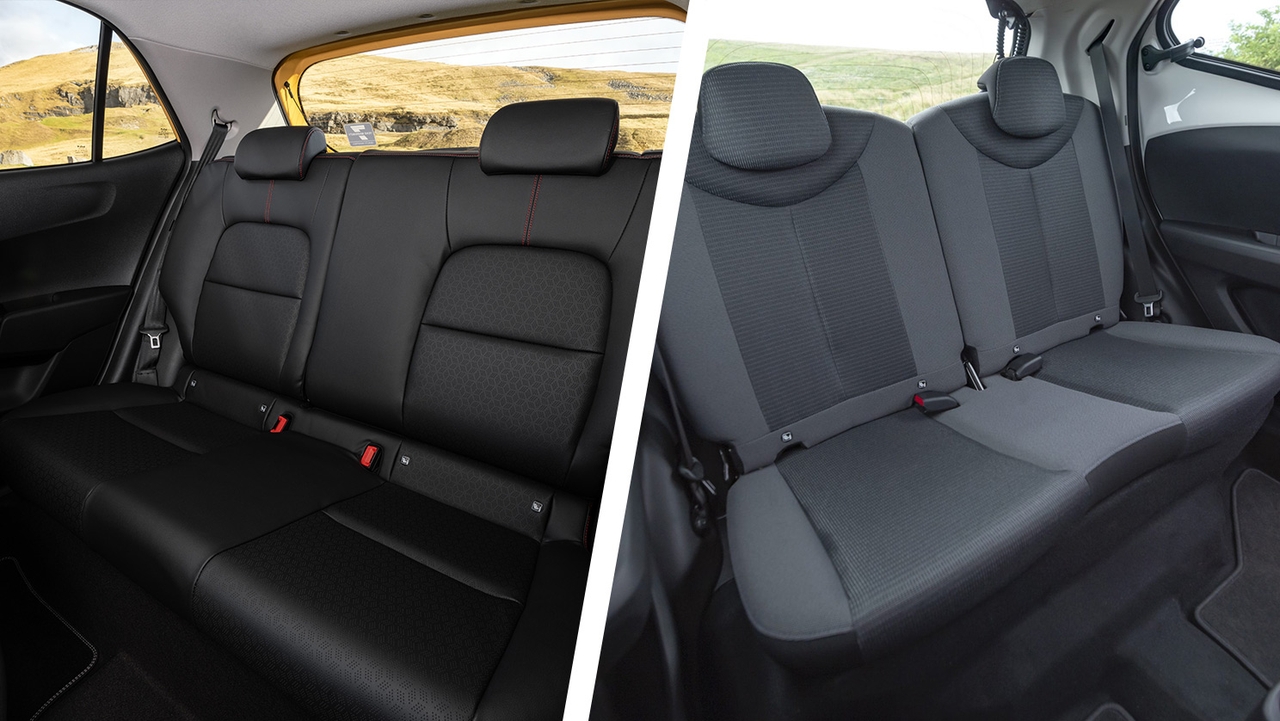
Prices for these two cars on the used market track very closely. However, it's worth bearing in mind that the Aygo is a little better equipped than the Picanto across entry-level and mid-range models, with air conditioning, cruise control, a reversing camera and an infotainment system all appearing sooner in the Aygo's trim level hierarchy than they do for the Picanto. You do get more cabin space in the Kia, however, so you'll be the best judge of which car represents better value for money.
Both of these cars should prove to be dependable, with both earning high scores across a range of reliability surveys. The Kia takes the lead on paper here thanks to its seven-year transferrable factory warranty – longer than you get in the Aygo. Of course, you have the option to add an extended warranty to either car, allowing you to make up the deficit.
Which is best?
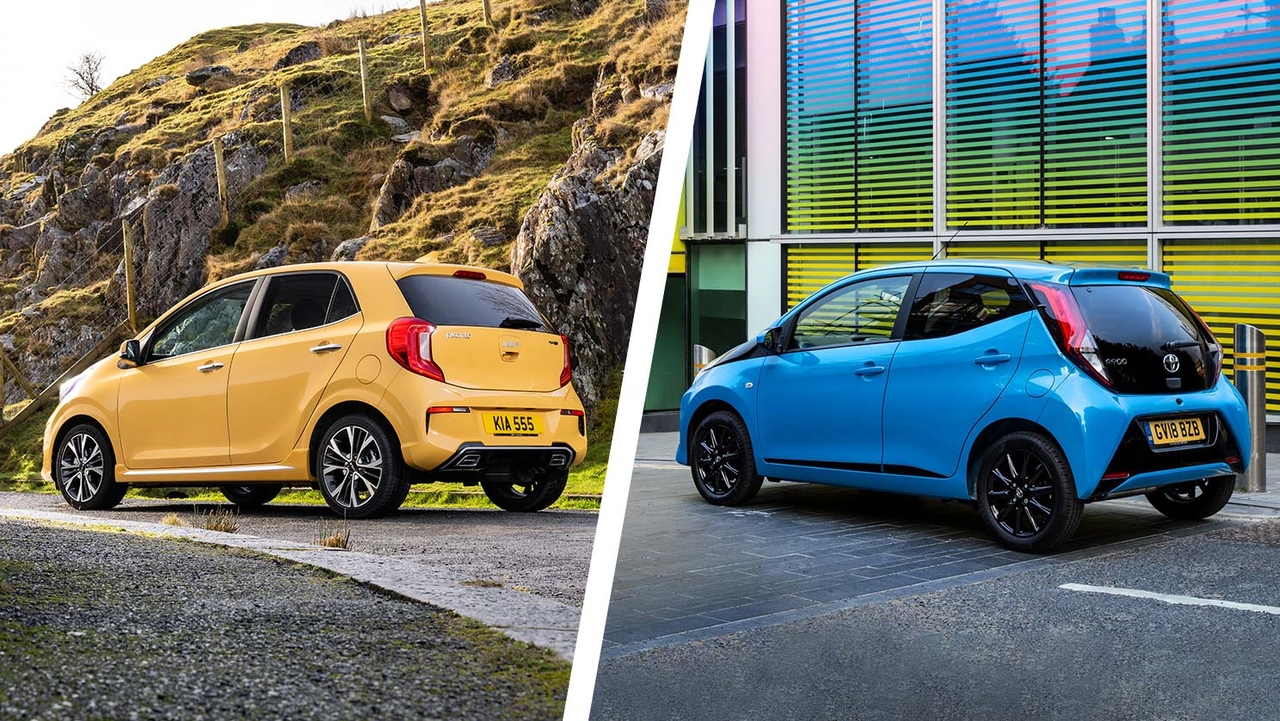
Your priorities can help guide your decision here. Shopping for used examples of either car with the same budget will see you encounter more Aygos with better standard equipment, including handy features like cruise control, A/C and an infotainment system. You might also appreciate the Aygo's youthful and colourful styling, which feels a little less conservative than the neat but unremarkable Picanto.
However, the Kia is noticeably larger inside despite barely taking up any more space on the road. It's also quite a bit better to drive with more entertaining handling and a greater sense of composure at higher speeds. Plus, with a pair of more powerful engines you can upgrade to, the Picanto makes a better choice if you'll be tackling the odd motorway trip.
Check out a huge choice of used Kia Picanto and used Toyota Aygo cars at Motorpoint. For more great options, see our list of the best small cars you can buy.

































